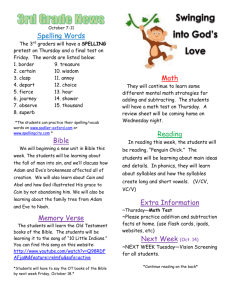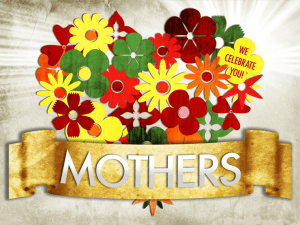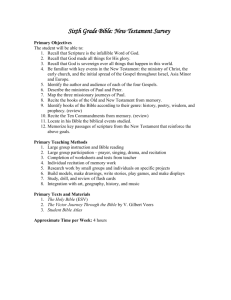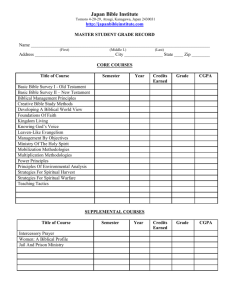September 20-31 Bible Lessons - St. John Bosco Catholic Church
advertisement
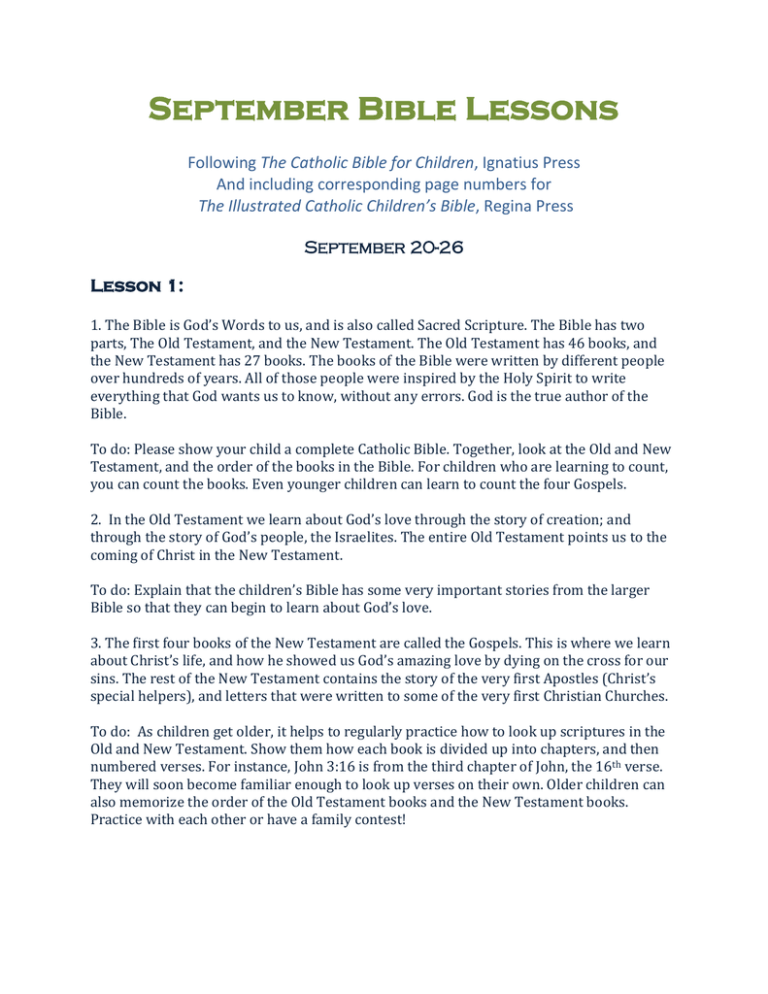
September Bible Lessons Following The Catholic Bible for Children, Ignatius Press And including corresponding page numbers for The Illustrated Catholic Children’s Bible, Regina Press September 20-26 Lesson 1: 1. The Bible is God’s Words to us, and is also called Sacred Scripture. The Bible has two parts, The Old Testament, and the New Testament. The Old Testament has 46 books, and the New Testament has 27 books. The books of the Bible were written by different people over hundreds of years. All of those people were inspired by the Holy Spirit to write everything that God wants us to know, without any errors. God is the true author of the Bible. To do: Please show your child a complete Catholic Bible. Together, look at the Old and New Testament, and the order of the books in the Bible. For children who are learning to count, you can count the books. Even younger children can learn to count the four Gospels. 2. In the Old Testament we learn about God’s love through the story of creation; and through the story of God’s people, the Israelites. The entire Old Testament points us to the coming of Christ in the New Testament. To do: Explain that the children’s Bible has some very important stories from the larger Bible so that they can begin to learn about God’s love. 3. The first four books of the New Testament are called the Gospels. This is where we learn about Christ’s life, and how he showed us God’s amazing love by dying on the cross for our sins. The rest of the New Testament contains the story of the very first Apostles (Christ’s special helpers), and letters that were written to some of the very first Christian Churches. To do: As children get older, it helps to regularly practice how to look up scriptures in the Old and New Testament. Show them how each book is divided up into chapters, and then numbered verses. For instance, John 3:16 is from the third chapter of John, the 16th verse. They will soon become familiar enough to look up verses on their own. Older children can also memorize the order of the Old Testament books and the New Testament books. Practice with each other or have a family contest! Lesson 2: The Creation of the World, pg. 10-13, Genesis 1:1-2:4 Pg. 4-6 in The Illustrated Catholic Children’s Bible 1. God Made Everything! What are some of the amazing things that God has made? Example: nature, animals, the sun, the moon and stars – everything! For younger children, as you go about your day together, make a game of pointing out the things that you see in nature and ask your child, “who made that?” to reinforce this lesson. 2. God created Adam and Eve, the first people. God told Adam to take care of the earth that He created, and He wants us to do the same. How can we take care of the beautiful world that God created? Example: clean up litter, water plants, plant trees. 3. He made each one of us, too. God called his creation “good.” That means that each one of us is special to him! He also wants us to take care of each other. How can you take care of others? Example: love each other, be kind to one another. Ask your child to try to take care of someone each day this week. 4. God created us in His image. What do you think that means? Example: We believe that God made us in His image and likeness. Only people are made in the image of God and are able to know and love their Creator. (See Catechism No. 356). This is why God made us: to know and to love Him. 5. God is powerful enough to create the whole world and we know that He is powerful enough to take care of us. There is no problem that is too hard for Him. God wants each person to know Him and talk to Him. How can you get to know God better? Example: We get to know God when we read the Bible and go to Mass. We talk to God when we pray-- and we can tell Him anything! Lesson 3: Adam and Eve, pg. 14-15, Genesis 2:4-3:24 Pg. 6-9 in The Illustrated Catholic Children’s Bible 1. Even though Adam and Eve lived in the beautiful Garden of Eden and had everything that they needed, they still chose to disobey the one rule that God had given them. What was that rule? Answer: Eating the fruit from the tree of the knowledge of good and evil. 3. God made Adam and Eve with something called free will. This means that they could decide whether to obey Him or not. We have free will, too. When Adam and Eve disobeyed God, that was the first sin committed by people. Sin is choosing to disobey God’s rules. Talk about times when we have to choose between right and wrong. Example: obeying parents, being kind, telling the truth, sharing, following rules at school. It isn’t always easy to obey, but we can ask God to help us! 4. Because Adam and Eve chose to disobey God, they had to leave the beautiful garden forever. They were sad because they knew they would not be as close to God anymore. From then on, all people would be affected by Adam and Eve’s sin. This is called original sin. Because we all come from Adam and Eve, each of us is born with original sin. And because of this original sin, our nature is weaker and we are easily tempted to do things that are wrong. God loves us and wants us to be close to him again, so he gives us grace through Baptism. When a person is baptized, original sin is erased, and that person becomes a child of God. The grace that God gives us when we are baptized is a special gift that helps the baptized person be close to God again. Baptism is one of the seven Sacraments of the Catholic Church. Review with your child that everyone needs baptism to erase original sin. If your child has been baptized, talk to them about their baptism. (Anyone in need of Baptism, please contact the church!) Example: You can look at pictures, talk about their godparents, or show them their baptismal candle. Look up the date of their baptism and help them put it on the calendar. When that day arrives, you can light their candle and have a little celebration for the day that they became part of God’s family. Remind your children to bless themselves with holy water every time they enter or leave the church. This reminds us of our baptism and our close friendship with God. September 27- 31 Lesson 4: Cain and Abel, pg. 16-17, Genesis 4:1-16 Pg. 10-11 in The Illustrated Catholic Children’s Bible 1. Adam and Eve’s sons, Cain and Abel, both brought offerings to God. However, God was only pleased with Abel’s offering. This made Cain very jealous. What does it mean to be jealous? Example: sometimes people become jealous when someone has something that they want instead of being happy for them, or they might become jealous when someone else gets attention. If we think of other people in a loving way and want what is best for them, then we will not give jealousy any room to grow in our hearts! 2. Cain was so jealous and angry that he attacked his brother and killed him. God knew exactly what he had done, but Cain tried to lie to God. No one can hide from God. God sees us every minute of every day! He always knows what we are doing, and what we are thinking. When we are tempted to do things that we shouldn’t, what should we remember that can help us do the right thing? Answer: we should remember that God can see us and that he knows our thoughts. We should want to please God with our thoughts and actions. 3. There are always consequences for sin. Cain’s punishment was that he had to leave God’s presence and his family and wander the earth for the rest of his life. Cain had committed a grave (very serious) sin. Instead of admitting he was wrong, he lied to God. Sin separates us from God. God wants us to be honest with him when we do something wrong. We can go to Reconciliation and confess (tell) our sins to the priest. If we are truly sorry for our sins, God forgives us through the words of the priest (absolution). Reconciliation makes us close to God again. It is one of the seven Sacraments of the Catholic Church. Lesson 5: Noah’s Ark, pg. 18-21, Genesis 6:5-9:17 Pg. 12-15 in The Illustrated Catholic Children’s Bible 1. Many, many years had passed after the time of Adam and Eve. (Remember that all people come from Adam and Eve and are born with original sin. Original sin means that our nature is weakened and we are tempted to do things that are wrong.) Almost all of the people on the earth had become very evil. They had free will to choose between right and wrong, and they chose to live very wicked lives. God knows everything, so he could see that the only one choosing to do the right thing was a man named Noah. To do: Review the concept of original sin and free will with your child. What Sacrament is needed to erase original sin? (See lesson 3.) 2. God told Noah to build a large boat, the Ark. He was going to send a huge flood to destroy all of the wicked people on the earth, but he would save Noah and his family as well as two of every living creature on the earth. The Ark was very big. Imagine what all of the wicked people were thinking as Noah built a giant boat on dry land! They may have even made fun of him! Sometimes it is not easy to do the things that God wants us to do, even when we know should obey God. To talk about: Can you think of a time when someone teased you for doing the right thing? (You or your child may have a story to share.) We can always ask God to help us be strong enough to follow him! 3. God sent the rain to cover the earth. The Bible tells us that it rained for forty days and forty nights! God kept his promise to Noah and his family and they remained safe in the Ark. When they were finally able to leave the Ark, God placed a beautiful rainbow in the sky and made a covenant (promise) with Noah that he would never send a flood like that again. To talk about: God always keeps his promises! We can always trust him to take care of us! It is important for us to keep our promises, too. 4. The Catechism of the Catholic Church tells us that the great flood and Noah’s ark prefigure (show us ahead of time) our salvation through the waters of Baptism. The wicked people were destroyed, the eight people in Noah’s family were saved, and God gave them a new beginning. (See Catechism Nos. 1094 & 1219). This is one of the reasons that it is so important to study the Old Testament, too!
